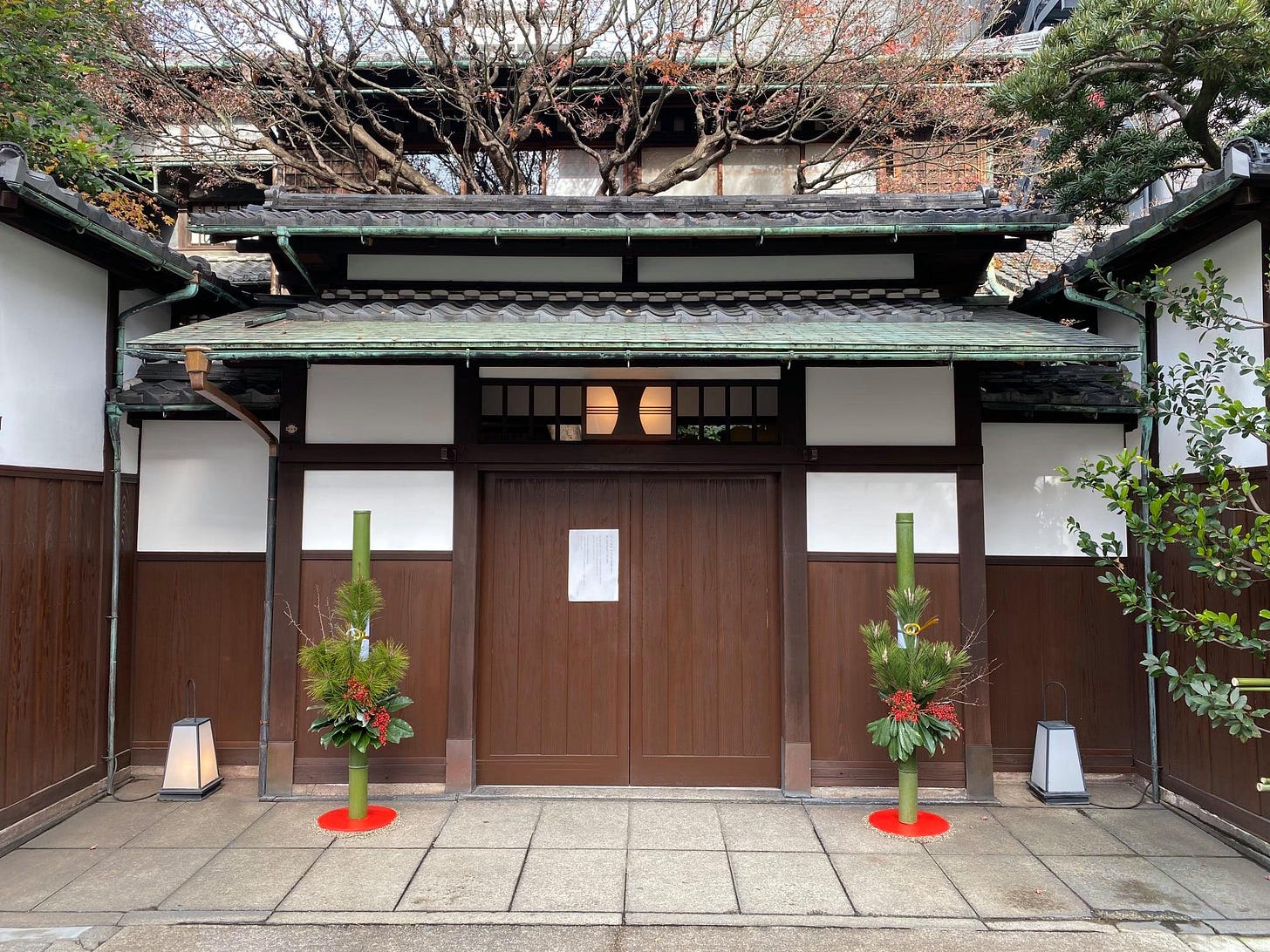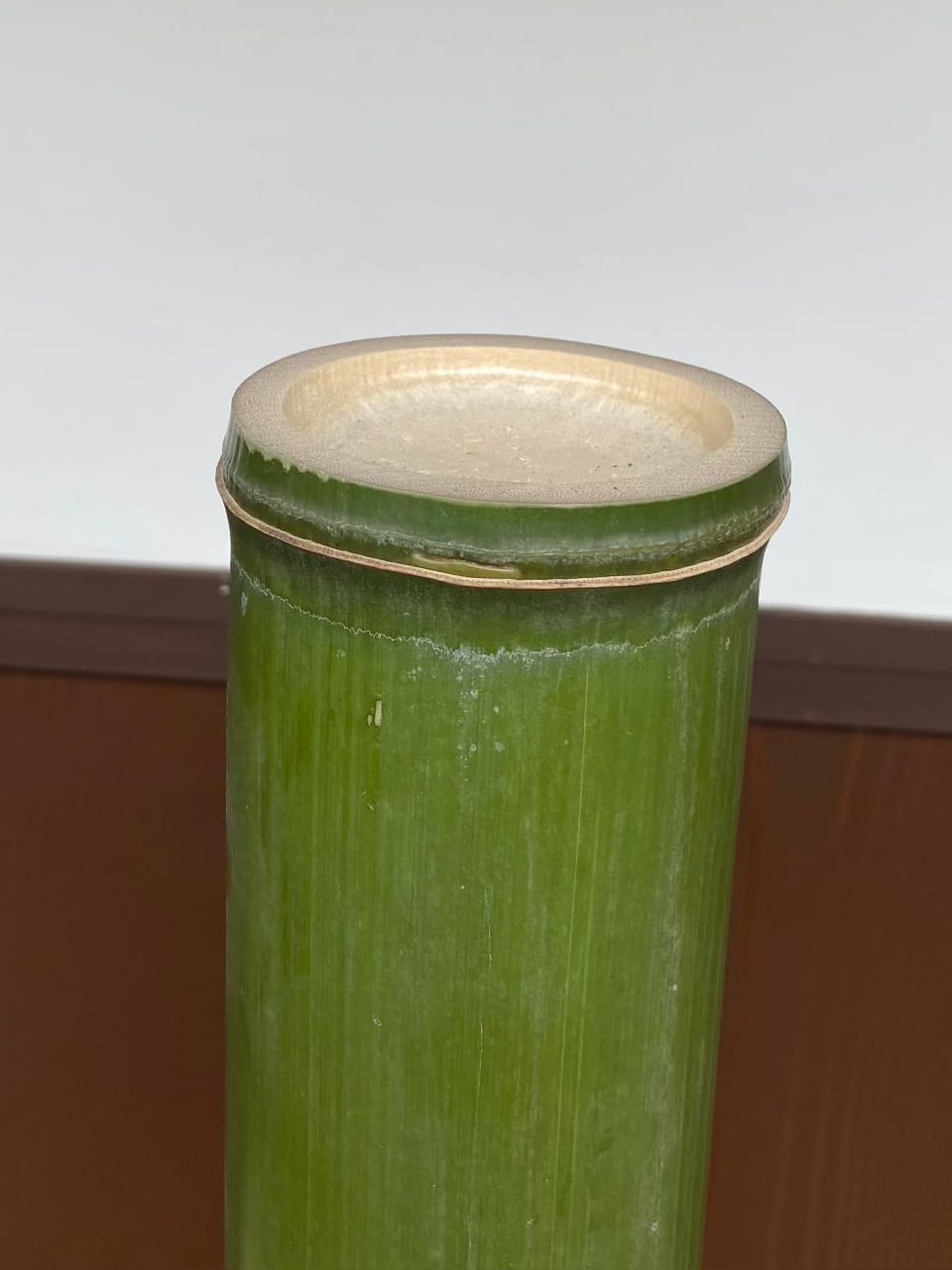Kadomatsu are traditional New Years decorative arrangements of bamboo, pine and plum branches displayed in pairs (representing male and female) as temporary shrines in front of homes and businesses to welcome the ancestral spirits and gods of harvest.
Samurai residences would have such displays at the outer gates to the property, or flanking the genkan, entrance hall of the home from just before, until just after the New Years’ period.
The name, kadomatsu literally means “pine gate”, and originally featured pine trees rather than bamboo, the use of which began during the Kamakura period. Evergreen pine trees were considered a symbol of vitality, longevity, and prosperity. Among the many evergreen trees, pine trees were also believed to be the home of the gods, and that the gods descended to earth at New Years using these pine gates as landmarks.
During the Heian period, an event called Ko-matsu-hiki was held at the Imperial Court. Aristocrats and elite warriors would go out on the day of their first child's birth and pull up a small pine tree. The Ko-no-hi pine that they brought back — roots and all — was a prayer for the child’s longevity and put on display. This is thought to have evolved into the kadomatsu culture. Even today, in old houses in the Kansai region, not cut, but rooted pine trees, nehiki no matsu are displayed on both sides of the home’s entrance, often adorned in white washi paper and draped with gold and red mizuhiki decorative strings to welcome in good fortune.
Typically displayed from late December until January 7 the designs vary depending upon region. The central portion of most kadomatsu currently features three large bamboo stalks, cut on an angle and set at different heights. These are supposed to represent Heaven (the highest stalk) Humanity (the middle stalk) and Earth, although some regions have the Humanity and Earth bamboo positioned at the same height. All are bound with straw rope, and often surrounded by woven mats of straw.
In the Kanto region, (eastern Japan around the Tokyo area) the displays often feature a set of three bamboo stalks, with shorter young pine trees around the periphery and the bottom wrapped in straw. In the Kansai (western Japan, Osaka) region, they feature a set of three bamboo stalks, with red and white chrysanthemums in the front, taller young pine trees in the back, and the bottom wrapped in bamboo. For more extravagant designs, they are often decorated with plum blossoms, nandina, Japanese kumazasa, and leaves of the ornamental yuzuriha.
Traditionally samurai families, particularly in the central Owari and Mikawa regions (modern day Aichi Prefecture) used a single upright stalk of bamboo, cut straight at the top in a style known as Zundo.

Types of Kadomatsu
There are two types of kadomatsu bamboo tops: sogi, in which the bamboo is cut diagonally, and zundo, which is cut straight across the bamboo’s segmented joint. One story suggests that the sogi style was started by Tokugawa Ieyasu, who, in anger had cut down a kadomatsu display with his sword immediately after Ieyasu’s worst ever defeat at the Battle of Mikatagahara in January 1573. After retreating, the Takeda sent a poetic message to Ieyasu claiming "Matsukare de Takerui inaki ashita kana" (Tokugawa Ieyasu, descendant of the Matsudaira clan, shall perish, and the Takeda will flourish like never before). This angered Ieyasu, who cut down the bamboo and reinterpreted the phrase sending his reply to the Takeda forces stating: "Matsukare de Takeda kubinaki ashita kana" (The Matsudaira clan will not perish, but the Takeda's head will fall), and sent it back, along with the kadomatsu with its bamboo head (take 竹, a word play dig at the Takeda) cut diagonally. This sparked a trend for Ieyasu’s vassals to follow suit, and soon all kadomatsu were displayed with a diagonal cut. During the Edo period, with samurai and daimyo coming and going, the often seen diagonally cut kadomatsu became the norm in the provinces too, remaining to this day. In Yamanashi Prefecture, however, where the Takeda clan originated, cylindrical bamboo pine decorations known as Takeda-style kadomatsu are nowadays displayed in official places such as the Yamanashi Prefectural Government Building.
Unlike modern day kadomatsu, Edo period kadomatsu were not cut short, but were displayed tall enough to reach the second-floor roof of a house. In the samurai houses of the Sendai domain, pine branches were tied to chestnut or sawtooth oak trees about 3 meters tall, and bamboo was placed between them, forming a gate-like structure for hanging shimenawa bound twisted ropes and straw decorations. The kadomatsu decorations at Sendai Castle continually increased in size and extravagance, eventually reaching a height of 4 meters, with the materials for these displays donated by eight Okado-matsuagenin, residents of Neshiroishi Village (now part of Izumi Ward, Sendai City) who raised the kadomatsu. The Sendai Castle kadomatsu became so extravagant that the people who donated the kadomatsu petitioned for tax exemption, and so at the end of the Edo period, the domain issued a ban on kadomatsu displays.
Installation : Matsumukae
On December 13th (or afterwards), a Matsumukae ceremony is held in which pine trees or branches are brought down from the mountains. It is also called noborimatsu, hanamukae, hanabiki, matsubayashi, amongst other titles. This ceremony welcomes the pines and New Year's deity from the mountains.
Beliefs Regarding Installation
Kadomatsu should be installed after December 13th, however, putting them up on December 29th is considered inauspicious so it is avoided, along with December 30th and December 31st, New Year's Eve as this would be seen as neglecting the gods.
Matsunouchi
The period during which kadomatsu are displayed is called Matsunouchi, and traditionally it was from New Year's Day to the 15th. In the Kansai region and other areas, it still lasts until the 15th, but in recent years, mainly in Kanto, it has become common to end Matsunouchi on January 7th, and therefore the decorations are often removed in the evening of the 6th or early the following day.
The removal of kadomatsu is called either matsu oroshi, matsu agari, matsu hairai, matsu hiki, matsu okuri, matsu no ume, depending on the region. The time immediately after New Year's kadomatsu are taken down is called matsu sugi. Kadomatsu are traditionally burned after use, around January 15 or 19.
Most Kadomatsu displayed around Japan at this time of year have the tops of the bamboo cut cleanly off at an angle, as though cleaved with a sword in anger, and may well hark back to the winter of 1573, when Tokugawa Ieyasu cut them down, creating a new style of traditional display that remains to this day.
Samurai History & Culture Japan is a reader-supported publication. To receive regular new posts, access the archives and support my work, please consider becoming a paid subscriber.








